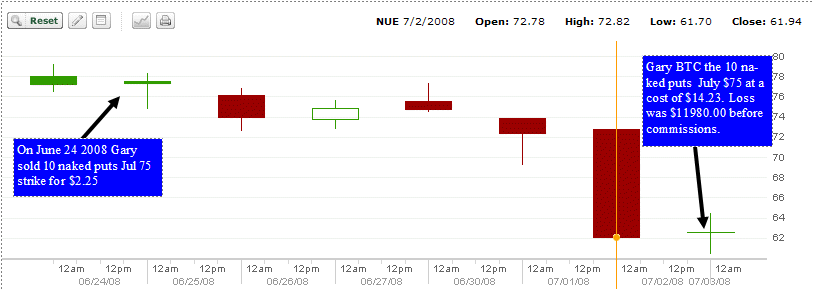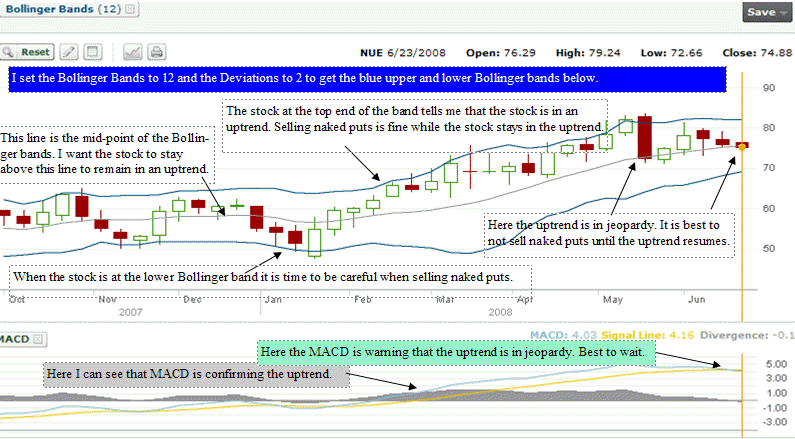In July 2008 I
received an email from an
investor, Gary asking for help.
Here is what happened: On June
24 2008 Gary sold 10 naked puts
on Nucor at $75.00 for $2.25 for
a total income of $2250.00
before commission. 6 days later
the stock closed at $61.94. The
cost to close the naked put was
14.80.

This
represented a loss of 557%. That
is a staggering loss. When the
stock fell on Jul 2, he was
shocked and the following day he
closed the put and paid 14.23
for a cost of $14230.00. The
loss was $11,980.00. (There was
no bounce back up just more
downward moves) In his email,
Gary explained that the loss was
still substantially less than if
he had bought the stock on Jun
24 and sold it on July 3. He
asked me if I knew what he could
have done to protect himself
from making the same mistake in
the future. I told him the best
I could do was show him the
tools I use and how I use them.
THE TOOLS
I USE:
1) I sent Gary a
number of images. The image
below was from May 8 to June 10
2008. I explained that the stock
on May 19 2008 set a new all
time high on Nucor and then it
fell 14.6% in just 4 days. This
makes the new high very suspect
that this could be a trap. On
May 20 the day AFTER the new
high, MACD went negative with a
reading below 0.00. A warning
that the stock is under
pressure. After May 23 the stock
bounced higher but MACD did not
go positive until June 5. On
JUNE 6 the stock fell which then
is a warning that the May 19
2008 new high is not confirmed.
A new high should be followed by
some pullback but the trend
should continue higher. However
after June 5 MACD did not
confirm an uptrend, but sideways
and within a day it was neutral
at 0.00. All these were warning
signs for Gary to hold off
selling the naked puts.

2) Gary had sent
me an image showing the purple
line below and indicated that he
was sure the stock was going to
break out. I sent him the image
below and showed him I thought
the stock seemed in a downtrend.
However to confirm either I
looked at MACD and it definitely
did not confirm any uptrend in
progress. This is a definite
warning sign. Remember the stock
is sitting close to its all time
high. The best course of action
here is to wait for a clear
direction.

3) I also sent
Gary the below image. NUE all
the way back to Oct 2007. I set
the Bollinger Bands to 12 and
the standard deviation to 2.
When the stock stays at the
upper end of the Bollinger Band
the stock is in an uptrend and
it is a better time to sell
naked puts. However by the time
Gary sold his Naked Puts on June
24 2008, the Bollinger Band was
warning that the uptrend was in
jeopardy which means this is
time to hold off on selling
naked puts. I have added MACD
(Moving Average Convergence
Divergence) which shows again
that the uptrend was confirmed
in February right through to
May, but by the time Gary sold
the naked puts, the uptrend is
no longer confirmed. This is
time to be careful. MACD is a
momentum indicator that takes
two moving averages of prices
and shows their relationship to
present a buy and sell signal
for investors.
The settings I
use are, Fast Points of 12 which
is for the 12 day EMA and the
slow points of 26 which is for
the 26 day EMA. The smooth I use
is 9 which is the 9 day EMA
(mid-point on the Bollinger)
which many people refer to as
the signal line. So basically I
am comparing the movement of the
12 day and 26 day and plotting
it against the 9 day EMAs. It's
pretty accurate at spotting the
changing in trend. It does not
predict a change, just confirms
the current trend.

4) There are lots
more other tools that can be
used but I prefer the above
tools.
An investor could also
use the 10-20-30 moving
averages. To read that strategy
click here.